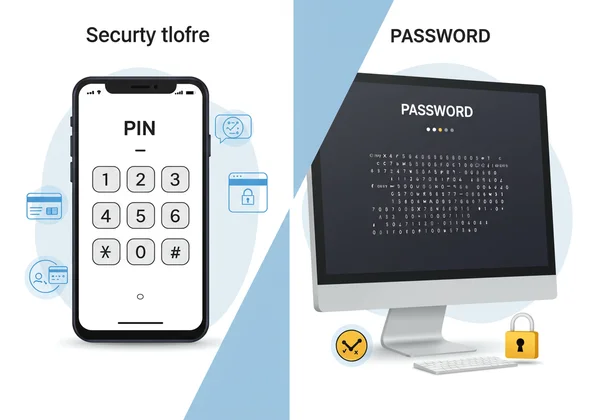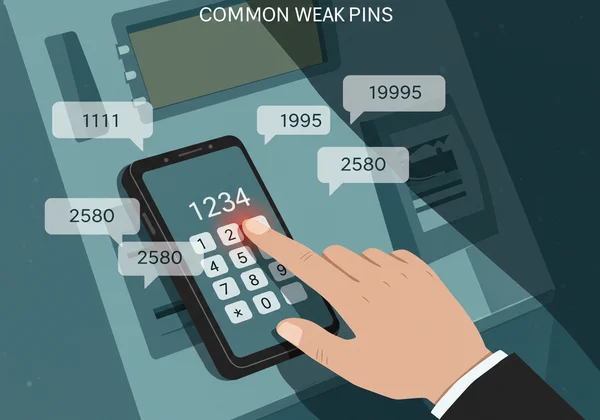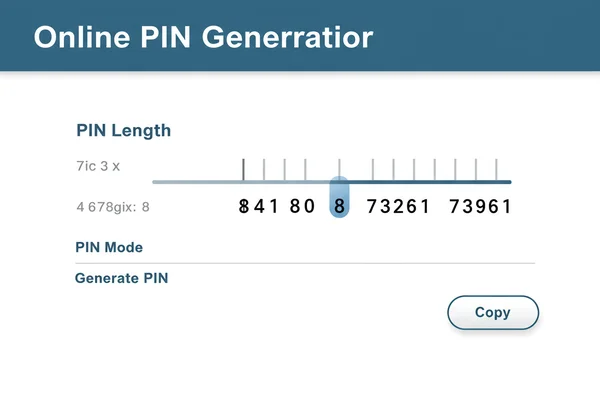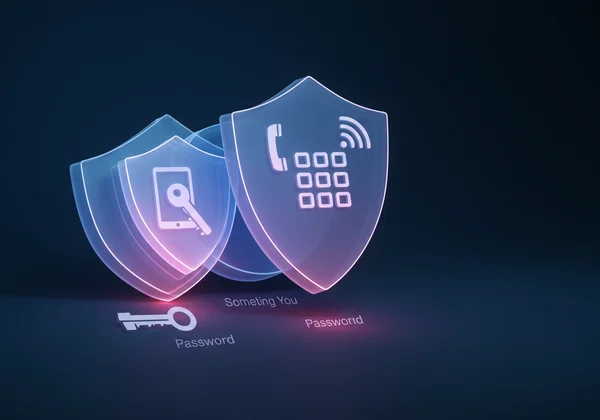Online Password Generator: Create Strong & Secure PINs with Our PIN Generator
From unlocking your smartphone to securing an ATM transaction, PINs are a constant in our daily digital lives. But how secure are yours? Many people overlook the importance of creating a strong PIN, often resorting to easily guessable combinations that leave them vulnerable. That's where a dedicated PIN generator becomes an indispensable tool.
This guide will walk you through everything you need to know about PINs, from their core function to the threats they face. More importantly, we'll show you how to create truly random and robust codes using a safe and reliable secure PIN generator. By understanding the principles of PIN security, you can take a simple but powerful step toward safeguarding your most sensitive information.
What is a PIN and How Does it Differ from a Password?
While often used interchangeably in casual conversation, PINs and passwords serve distinct purposes and are built on different security principles. Understanding this difference is key to using them correctly and maximizing your online security. A PIN is a specific type of password, but not all passwords are PINs.
The Core Difference: Simplicity vs. Cryptographic Complexity
The most apparent difference lies in their structure. A PIN is almost always a short sequence of numbers, typically ranging from 4 to 8 digits. This inherent simplicity is by design, making it fast to enter on keypads, whether physical (like an ATM) or digital (like your phone's lock screen). A password, on the other hand, is built for cryptographic complexity. It leverages a mix of uppercase and lowercase letters, numbers, and symbols to create a long, unpredictable string that is difficult for computers to guess.
A password's strength comes from its entropy—a measure of its randomness. The more character types and the longer the password, the higher its entropy and the more resistant it is to brute-force attacks. A PIN's security relies less on its own complexity and more on the system that protects it.

When to Use a PIN vs. a Full Password for Security
The context in which you use an authenticator determines whether a PIN or a password is more appropriate. Knowing when to use each is crucial for maintaining robust digital hygiene. A device unlock PIN is a perfect example of a PIN used correctly.
Use a PIN for:
- Device Access: Unlocking smartphones, tablets, and some computers.
- ATM/Debit Card Transactions: Authorizing withdrawals and purchases.
- Two-Factor Authentication (2FA): As a secondary code sent to your device.
- Parental Controls: Restricting access to certain content or apps.
Use a full password for:
- Online Accounts: Email, social media, online banking, and e-commerce sites.
- Software and Applications: Logging into programs on your computer.
- Encrypted Files and Drives: Protecting sensitive data stored locally.
Why PIN Security Matters: Common Weaknesses & Threats
Because PINs are short and numeric, many users fall into the trap of choosing weak, memorable codes. This convenience comes at a steep price, opening the door to various threats. To create secure PINs, you must first understand the risks associated with weak ones.
The Dangers of Easy-to-Guess PINs and Common Mistakes
One of the most significant vulnerabilities in PIN security is human nature. We are creatures of habit, and this reflects in our PIN choices. These common mistakes make a hacker's job incredibly easy. Attackers often start by trying predictable combinations like:
- Sequential numbers:
1234,4321,5678 - Repeated digits:
1111,0000,8888 - Significant dates: Birthdays, anniversaries, or graduation years (e.g.,
1995). - Keyboard patterns:
2580(a vertical line on a keypad).
These PINs are susceptible to both guessing and "shoulder surfing," where someone physically watches you enter your code. A random, meaningless number is always a safer choice.

Understanding Brute-Force Attacks and Limited Attempts
A brute-force attack is a method where an attacker uses software to try every possible combination of numbers until the correct one is found. For a 4-digit PIN, there are only 10,000 possible combinations (0000-9999), which a computer could guess in seconds.
Fortunately, most systems that use PINs have a built-in defense mechanism: limited attempts. Your bank's ATM, for instance, will swallow your card after three incorrect tries. Your smartphone will lock you out for an increasing amount of time after several failed attempts, eventually requiring a full reset. This system-level protection is what makes a short PIN viable for security, as it prevents automated brute-force attacks from succeeding.
How to Generate Secure PINs
The best way to avoid common pitfalls is to remove human bias from the creation process entirely. Using an online PIN generator ensures your code is truly random and unpredictable. Our secure PIN generator is designed for maximum security and ease of use.
Step-by-Step: Using Our PIN Generator Feature
Creating a strong numeric code is simple and takes only a few seconds. Our tool ensures the entire process happens securely within your browser.
-
Visit the Homepage: Navigate to generate a password.
-
Select PIN Mode: On the generator tool, click the "PIN" option. This will configure the generator to create a numeric-only code.
-
Choose Your Length: Use the slider to select the desired length for your PIN. While 4 digits is common, we recommend 6 or 8 digits for enhanced security if the service supports it.
-
Generate and Copy: Click the "Generate" button. A new, random PIN will instantly appear. Use the "Copy" button to securely copy it to your clipboard.

Critically, our generator is Client-Side Only. This means the PIN is created directly in your browser and is never sent to our servers. We do not see, store, or track your generated codes, offering you complete privacy and peace of mind.
Optimal Length and Character Considerations for PINs
When generating a PIN, the primary factor you control is its length. The optimal length depends on the system you're using it for. For modern applications like smartphone unlocking or high-security accounts, a 6-digit PIN provides one million combinations, making it 100 times more secure than a 4-digit one. An 8-digit PIN offers 100 million combinations.
Always opt for the longest PIN length a service allows. While our tool can generate passwords with various character sets, the dedicated PIN mode ensures you get a purely numeric code, which is the standard definition of a PIN.
Best Practices for PIN Management and Usage
Creating a strong PIN is only half the battle. Proper PIN management is essential for maintaining long-term security. Following a few simple rules can significantly reduce your risk of compromise.
Protecting Your PIN in Daily Life: Do's and Don'ts
Your habits in daily life play a huge role in keeping your PINs safe.
- DO cover the keypad with your hand when entering a PIN at an ATM or payment terminal.
- DON'T use the same PIN for multiple critical services, especially your bank card and your phone.
- DO use a unique, randomly generated PIN for every important account. A custom password generator is perfect for this.
- DON'T write your PIN down on a sticky note or store it in a plain text file on your computer.
- DON'T ever share your PIN with anyone, even if they claim to be from your bank or a service provider.
The Role of Multi-Factor Authentication (MFA) with PINs
PINs are powerful when integrated into a multi-factor authentication (MFA) strategy. MFA requires you to provide two or more verification factors to gain access to an account. A PIN can serve as the "something you know" factor.
For example, logging into your bank account might require your password (something you know) and a one-time PIN sent to your phone (something you have). This layered approach means that even if a hacker steals your password, they still cannot access your account without the temporary PIN.

Master Your PIN Security: A Step Towards Stronger Digital Protection
Ready to truly secure your devices and accounts? Remember, randomness is your most powerful defense against weak PINs. Stop relying on predictable combinations and start generating truly strong, unique PINs for every critical access point. Our online password generator makes it easy, fast, and completely private – all codes are created directly in your browser. Create your secure PIN now and take that crucial step toward stronger digital protection. It's free, instant, and ensures your privacy.
Frequently Asked Questions About PIN Security
Is an online PIN generator safe to use?
Yes, but only if it operates on the client side. Many online tools generate codes on their servers, creating a potential security risk. Our password generator is built on a "Client-Side Only" principle. All generation happens within your browser, meaning your PIN is never transmitted over the internet or stored anywhere but your own device. This makes our password generator free tool as safe as creating a code offline.
How long should a secure PIN be?
For modern security, a PIN should be at least 6 digits long. A 4-digit PIN has 10,000 combinations, whereas a 6-digit PIN has 1,000,000. While 4 digits may be sufficient for systems with strict attempt limits (like an ATM), a longer PIN is always better. If a service allows for 8 or more digits, use them to maximize your protection.
Can a PIN be as strong as a password for certain uses?
In specific contexts, yes. A PIN's strength comes from system-level protections like lockout mechanisms. For unlocking your phone, where you only get a handful of tries, a 6-digit PIN can be extremely effective. However, for an online account without such strict limits, a complex password with letters, numbers, and symbols is far superior and absolutely necessary.
What are common examples of where to use a secure PIN?
A secure, randomly generated PIN is ideal for a variety of everyday applications. Common examples include unlocking your smartphone or tablet, accessing your bank account at an ATM, arming or disarming a home security system, authorizing transactions with a credit or debit card, and as a verification step in a multi-factor authentication process.